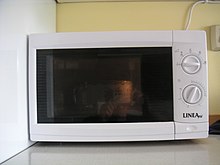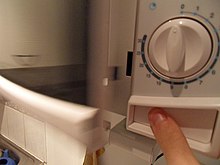Microwave
The microwave oven is a household appliance used in the kitchen to cook or heat food that works by generating electromagnetic waves with a radiation frequency of around 2450 MHz (2.45x109 Hz).
History of the microwave oven
Like other inventions, the microwave oven is the secondary application of a technology intended for other purposes. In 1945, during research related to radar, Dr. Percy Spencer, an engineer for the Raytheon Corporation, was testing a vacuum tube called a magnetron when he discovered that a chocolate bar in his pocket had melted. Suspecting that this had been caused by the waves emitted by the magnetron, Dr. Spencer placed some popcorn seeds near the tube as an experiment. The corn cooked and swelled. Spencer repeated the experiment using a chicken egg. Due to the rapid increase in temperature, the internal pressure caused the egg to explode. This encouraged him to continue experimenting with other foods.
Dr. Spencer designed a metal box with an opening through which radiation from the magnetron could enter. The metal walls confined the microwave radiation, so the energy from the electromagnetic field was not diffused, but concentrated within of said walls. When food was introduced, its temperature increased. Other engineers worked on improving Dr. Spencer's prototype, and in late 1946, the Raytheon Company applied for a patent for microwaves in food preparation. The first test oven, which heated food using microwave energy, was installed in a Boston restaurant.
In 1947, the first commercial microwave oven came on the market. These first units were cumbersome, 1.60 m tall and 80 kg in weight. The magnetron was cooled with water, so it was necessary to install a special circuit. In addition, their price was high: they cost around 5,000 dollars each, so they were not very well received.
The development of a new air-cooled magnetron eliminated the need for refrigeration piping, allowing for cheaper and more manageable furnaces. Fast food businesses were the first to recognize its usefulness.
When the food industry discovered the potential and versatility of the new invention, it was applied to a variety of uses, such as dehydrating vegetables, roasting coffee or nuts, thawing and cooking meat, opening oysters, pasteurizing milk, etc. Other industries used it for drying cork, ceramics, paper, leather, tobacco, textile fibers, pencils, flowers, damp books, and matches. Microwaves were also used in the curing process of synthetic materials such as nylon, rubber, and urethane. However, due to distrust of the new 'electronic radar ovens', it was not until the 1970s that it began to be used in domestic kitchens. No one died of "poisoning" by radiation, nor was he blinded, sterile or impotent due to the use of microwave ovens. As fears in the United States faded, acceptance increased and the myths were forgotten.
In 1971 less than 1% of American homes had microwaves, in 1978 the figure rose to 13%, reaching 25% in 1986. In 1975 sales of microwave ovens surpassed the number of gas cooktops for the first time. The following year it was reported that 17% of Japanese households cooked with microwaves, compared to 4% of American households. Today, microwave ovens have many improvements: timers, baking sensors and electrical resistances to gratin or finish browning the dishes that need it, since this cannot be achieved only with microwaves.
Components
A microwave oven consists of:
- A high voltage power supply, commonly a simple transformer or an electronic power converter, which passes energy to the magnetron.
- A high voltage electric capacitor connected to the magnetron, the transformer and through a diode to the chassis.
- A cavity magnetron, which converts high voltage electric energy into microwave radiation.
- A magnetron control circuit (usually with a microcontroller).
- A short wave guide (to couple the microwave power from the magnetron to the cooking chamber).
- A metal cooking chamber.
- A swivel dish
- A control panel.
Interferences
Microwave ovens, although shielded for safety reasons, still emit low levels of microwave radiation. This is not harmful to humans, but can sometimes cause interference to the Wi-Fi or Bluetooth signal and to devices that communicate on the 2.45 GHz wave bands; particularly at close range.
Operation of the domestic microwave oven
A microwave is an appliance intended for cooking or heating food that works by heating the water it contains or the liquids that are added. It works by generating high frequency radio waves. Water, fats, and other substances in food absorb the energy produced by microwaves in a process called dielectric heating (also known as electronic heating, RF heating, high-frequency heating, or diathermy). There are molecules, such as water, whose structure forms electric dipoles, which means that they have a partial positive charge at one end and a partial negative charge at the other, and therefore oscillate as they try to align themselves with the alternating electromagnetic field of the microwaves. When rotating, friction and shocks occur, which are what raise the temperature. Microwave ovens work as follows: a device called a magnetron converts electrical energy into microwave energy, which then reaches the food. Electromagnetic waves agitate the bipolar molecules present in food, especially those in water, and these are the ones that raise the temperature. This agitation is a physical mechanism, simple movement of the molecules to the rhythm of the frequency, and it does not cause any type of alteration in the chemical composition (except those that are produced by the increase in temperature).
Microwave heating is more efficient in liquid water than in frozen water, since in the solid state of water the movement of molecules is more limited. It is also less efficient on fats and sugars because they have a lower molecular dipole moment than liquid water.
Sometimes microwave heating is explained as a resonance of water molecules, but this is incorrect, as this resonance only occurs in water vapor and at much higher frequencies (around 20 GHz). On the other hand, large industrial microwave ovens that generally operate on the 915 MHz frequency (32.8 centimeter wavelength) also heat water and food effectively.
Sugars and triglycerides (fats and oils) absorb microwaves due to the dipole moments of their hydroxyl or ester groups. However, due to the lower specific heat capacity of fats and oils and their higher vaporization temperature, they often reach much higher temperatures inside microwave ovens. This can cause oil or very fatty foods, such as bacon, temperatures well above the boiling point of water, becoming toasted in a similar way to roasting on the conventional grill or in deep fryers. Foods high in water and low in oil rarely exceed the boiling point of water (100°C).
Microwave heating can cause overheating in some materials with low thermal conductivity, which also have dielectric constants that increase with temperature. An example of this is glass, which can show thermal runaway in a microwave oven up to the melting point. Additionally, microwaves can melt some types of rock, producing small amounts of synthetic lava. Some ceramics can also be melted, and can even lighten in color when cooled. Thermal runaway is more typical of electrically conductive liquids, such as salt water.
A common misconception is that microwave ovens cook food from the inside out, that is, from the center to the outside of the food. This idea arises when observing the cooking of foods with a drier outer layer and a more humid interior; Culinarily expressed as crunchy on the outside and soft on the inside. In most cases, in foods that are uniformly structured or reasonably homogeneous in their physical composition, microwaves are absorbed from the outside in similar to other heat cooking methods. Depending on the water content, the depth of initial heat deposition can be several centimeters or more with microwave ovens, in contrast to roasting (infrared) or convective heating (methods that deposit heat on a thin layer of the surface of the food). The penetration depth of microwaves depends on the composition of the food and the frequency, with lower microwave frequencies (longer wavelengths) being the most penetrating. Microwaves penetrate only 2-4 cm into food, so the center of a large portion will not be cooked by the energy of these waves, but by the heat produced in the oven and by they transfer the superficial parts that are indeed reached by the waves.
Precautions
Most governments, industries and the WHO itself defend its use as a safe appliance for health, taking into account that the electromagnetic radiation emitted by a microwave oven (with a typical frequency of 2450 MHz) and the associated magnetic field to their magnetron they are not ionizing, that is, they are not capable of ionizing atoms by removing electrons from them. Due to the action of this magnetic field, the water molecules move and collide inside the food and heat it, but this action it is innocuous.
Microwaved food is considered safe and does not lose its nutritional value during cooking. Microwaving only reduces cooking time, but does not alter the nutrients.
According to the WHO, if the manufacturer's instructions are followed correctly, the microwave oven is safe and convenient for cooking a wide variety of foods. The risks derived from the misuse of the microwave can be avoided by strictly maintaining the following security measures:
- Carefully read the manufacturer's instructions before using the microwave oven and comply with them.
- Know and control the cooking times of the oven to prevent burns when removing very hot containers.
- Check that the microwave door closes properly and that the joints are not damaged. The microwaves are contained inside the oven and are not activated unless the door is closed and the oven on. In addition, the microwave walls have safety nets to prevent microwaves from going through. However, a damaged oven could have leaks, although radiation would have to be prolonged and at a very high level to harm the human body. To avoid risks, keep the microwave oven clean and in good condition and do not use it if there is visible damage.
- In attempting to perform a repair, safety measures must be respected, as there is a serious risk of electrocution, even having disconnected the electrical grid apparatus, by the presence of a large capacity capacitor.
- Use only microwave-specific containers and dishes. Manufacturers generally do not recommend introducing unfit plastic packaging, which could be melted, or metal containers that could generate sparks and electrical damage. It is recommended to use plastic containers manufactured and approved for microwave cooking, as well as silicone or pyrex containers, more resistant than glass.
- You can partially close the containers to concentrate the steam and get a more pair of cooking, but it is not advisable to close them hermetically because they could explode.
- It is recommended to restart food for several minutes after cooking so that heat is distributed evenly. Some thick pieces may take longer to cook or receive uneven cooking, so potentially dangerous microorganisms may not be completely eliminated.
- You have to take precautions by heating water or other liquids in the microwave. Overheated water may not enter into boiling despite over 100 °C due to the absence of the small air bubbles necessary to start the process, doing it unexpectedly and explosively by disrupting the liquid with a simple shake that unpacks the bubbles attached to the container, or by introducing them with a spoon or a lump of sugar, splashing liquid and gas at high temperature.
- You also have to be cautious about certain foods that have peculiar behavior in cooking microwaves. Foods with non-porous surfaces, such as hot dogs, or composed of parts with different cooking times, such as peel eggs or nuts with peel, could explode by steam pressure.
Contenido relacionado
Electronic musical instrument
Wine
Princess of Asturias Award for Scientific and Technical Research



